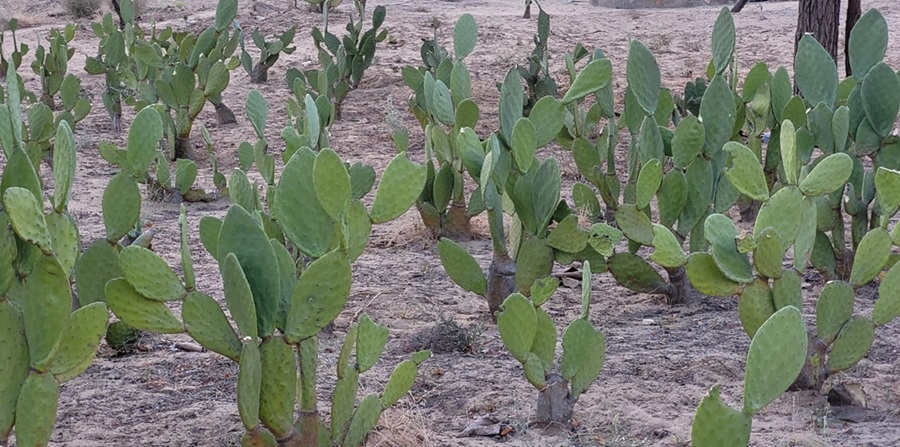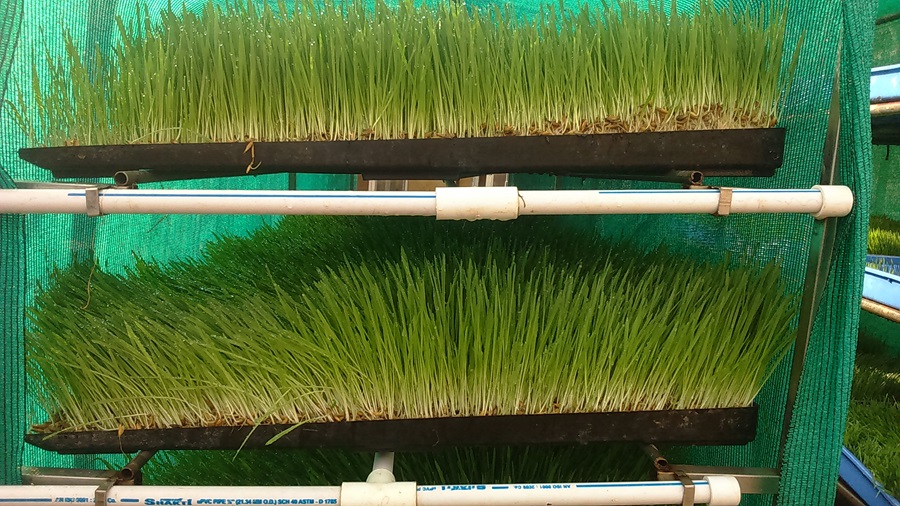
Increased anthropogenic pressure and livestock population have depleted the natural resources to an alarming extent. Land degradation accompanied by acute scarcity of water and frequent droughts, has resulted in a serious shortage of fodder for livestock. The situation which is close to a famine-like situation, has led to food insecurity and poverty forcing the rural population in such regions to migrate to other areas for survival.
Promotion of Unconventional fodder resources
There is a need to explore new fodder crops to address the issue of fodder scarcity in semi-arid regions. With 53.4 per cent of the land area in India comprising of arid and semi-arid regions, fodder cultivation is suitable for such areas. Unconventional fodder such as cactus (Opuntia ficus indica), Hydroponic fodder and azolla have good potential to serve as alternate sources of fodder for animals.
Spineless cactus : Spineless cactus also known as Prickly pear or Cactus pear, of Mexico origin and a member of the Cactaceae family, is a domesticated plant is a reliable source of food and fodder in arid and semi-arid regions of the country. Besides fodder, cactus also has the capacity to produce good biomass throughout the year with minimum water. It is a drought tolerant multipurpose plant species, easy to establish, in rangelands and pasturelands with its ability to facilitate soil and water conservation.
Cactus, is a Crassulacean Acid Metabolism (CAM) crop, where the stomata in the leaves remains shut during the day to reduce evapotranspiration but opens at night to collect Carbon dioxide (CO2). The stored CO2 is then used during photosynthesis during the day time. Due to this physiological character, it has high water use efficiency making it an excellent suitable crop species in water-stressed conditions. Cactus is rich in minerals such as calcium, magnesium, sodium, phosphorus and potassium and has moderate protein and fibre content. It has a high biomass yield, high digestibility, palatability and moisture content. It can be cultivated in poor, degraded land which is not suitable for other crops. Cactus leaf known as cladode, is a source of fodder for livestock especially during the dry season when green fodder is not available. Cactus contains more than 85% of water and can be fed with other fodder crops during dry spell conditions.

Thus cactus is an excellent fodder crop compared to other conventional fodder crops such as acacia. While this particular cactus species uses 267 kg of water per kg dry matter (DM) produced, Pearl millet, a prominent drought-tolerant cereal crop uses 400 kg water per kg DM produced.
Cactus may be planted during September-October or in February-March. It is propagated through the cutting of cladodes, using at least 6-month-old cladodes. To get a good yield of cladodes, cactus may be planted at a distance of 3 x 2 or 3 x3 m distance by erect planting, keeping one-third portion of the cladode above the soil on field bunds, wastelands and degraded lands. Perennial cactus can produce green fodder up to 20-25 years. Cactus cladodes should be harvested by cutting the mature cladodes with a sharp knife into small pieces. While feeding the animals, it should be mixed with dry fodder in 1:3 ratio. It prevents soil erosion, protects the biodiversity, and encourages arable crop diversification for sustainable livelihood and food security.
BAIF has standardized nursery techniques and tissue culture protocol for mass multiplication and production of cactus. Cactus nurseries have been established for availability of planting material. Protocol has been developed for feeding of cactus.
BAIF has introduced and demonstrated cactus on more than 1000 farmers’ fields in arid and semi-arid regions of Gujarat, Rajasthan, Karnataka, Andhra Pradesh and Maharashtra.
Hydroponics Technology for Fodder Production
Hydroponics fodder: To ensure the availability of quality green fodder throughout the year, hydroponic fodder production technology by vertical farming is being promoted. This low-cost technology, ensures the growth of fodder in water without any soil, in controlled conditions/environment which require almost no land, very little water and manpower. Seed, optimum water, sunlight and added nutrients are the only essential inputs required to grow as green fodder and as feed for animals after about 7-8 days. Farmers cultivating cereals such as maize, oats, barley, bajra and wheat are making good use of hydroponics to produce superior quality nutritious green fodder for animals.

Clean, viable, good quality and untreated, unbroken grains should be used. The seeds are soaked in normal water for 4-24 hours, depending on the type of seeds followed by draining, packing soaked seed in a gunny bag for germination, sprinkling water daily over the gunny bag to maintain optimum moisture and placing the germinated seed in the individual trays for growing inside the hydroponic unit. Water needs to be sprinkled every one hour on a tray and continued till harvest. The seed rate (quantity of seeds loaded per unit surface area) also affects the yield and varies with the type of seeds. The greenhouse needs optimum cleanliness and hygiene to be maintained to ensure successful production of hydroponics fodder.
To ensure green and quality fodder, BAIF has designed low-cost hydroponic fodder units for cultivation of maize and oats.
Azolla :Azolla is an aquatic fern and contains most of the nutrients, crude protein (about 23%), minerals such as calcium, phosphorus, potassium and magnesium, vitamins A and B12 and essential amino acids like lysine required for livestock.
Among the different species of the genus Azolla, A. pinnata is more popular for cultivation in artificial ponds. Azolla prefers shade and requires light (30-50%) for photosynthesis. It grows well in warm climate with an ideal temperature in the range of 20-35°C. Azolla can survive in a water pH range of 3.5–10, but optimum growth occurs when the water is between pH 4.5 and 7.

The soil needs to be dug at least at a depth of 20 cm depth and levelled. A plastic sheet 10 feet long and 4 feet wide needs to be placed on the ground with a durable polyvinyl chloride (PVC) sheet, to prevent water loss. The bed should be preferably under the shade of a tree or partial shade needs to be provided with grass or a green net on the top to prevent fall of debris like dried leaves and other litter on the bed. Azolla bed 12x4x1 feet size is also available in the market. About 10 – 15 kg of sieved fertile soil needs to be spread uniformly on the sheet followed by slurry made with 1 kg cow dung and 100 g of superphosphate. The bed needs to be filled with water to a level of about 10 cm and the pond left aside for 2-3 days to enable the ingredients to mix well. After 10-15 days, azolla will be observed on the bed and the farmer can harvest one kg Azolla every day. After harvesting, Azolla should be cleaned with fresh water and fed to the animals by mixing with regular feed.
To make available protein-rich nutritious fodder for cattle, goats and poultry, BAIF has set up azolla demonstration units on farmers’ fields in Maharashtra, Odisha, Karnataka and Gujarat.
Thus, unconventional fodder resources are a boon for smallholders in arid and semi-arid regions with scope for livelihood security and reversal of migration.


0 Comments